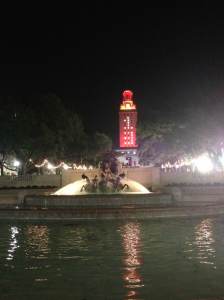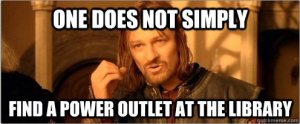Happy Blogversary to me!
To celebrate, I thought I’d post a little bit about some thoughts I’ve been having since I started my job at UC Irvine, particularly about the peculiar nature of my liaison assignments. For those who don’t remember, I was appointed to be the Research Librarian for the departments of Mathematics, Physics & Astronomy, and Classics. This puts me in the rather interesting (but not unique) position of being both a Humanities and a Sciences librarian at the same time. This odd combination means that I straddle the fence between the Humanities and the Sciences, and (I think) gives me a unique perspective on both worlds.
In 1959 British scientist C.P. Snow delivered a Rede Lecture at Cambridge University called The Two Cultures, in which he described the increasing demarcation of the intellectual regions of the arts from the sciences, a trend which has continued over the 50 years since the lecture. In libraries, we talk a lot in generalizations about the differences in the patterns of library activity that we observe in faculty on either side of the divide—humanities researchers use more books and science researchers tend to use more journals; humanities researchers prefer to browse a collection, while science researchers know the specific thing that they want and want it now. I’m in a particular spot to observe and think about these differences since I serve both sides of the divide, and I like to think that it makes me a more broad-minded librarian.
In 1964 in a second edition of the book of The Two Cultures, Snow described a third culture where those of the arts communicated directly with those of the sciences, but I see a third culture as the liminal borderlands between the two where humanities researchers use traditionally scientific, data-driven methods to conduct their research, and where scientists turn their eyes upon humanities topics. A great example of what this third culture, for me, is this incredible lecture by physicist Peter J. Lu that I got to see at UCI last year. Lu and his team used mathematical methods to examine girih (geometric star-and-polygon patterns in medieval Islamic architecture) and observed that after 1200 C.E. girih patterns were reconceived as tessellations of a special set of equilateral polygons (girih tiles) decorated with lines, which enabled the production of increasingly complex repeating periodic girih patterns.
I’ve been thinking about all these things a lot over the past eight months, and I believe librarians are the natural denizens of this third cultural space, especially librarians like myself who come to the sciences from the humanities. At UCI, we’re beginning to explore how we can support Digital Humanities researchers on campus, and some of our librarians have been involved in “cross-cultural” research (such as Dance researchers looks at Nursing topics). Since I’ve looked so intensely at research on either side of the divide, I feel like sometimes I have good ideas or a different perspective to offer that’s maybe beneficial to the discussions that we’re having. (Or maybe not, you’d have to ask my coworkers.) I wish more librarians had the opportunity to spend some time serving as a liaison for “the other side.”
However, this position is not without its challenges: it took me a while to understand how to code switch between helping a humanities researcher and helping a science researcher quickly, and while I understand scientific topics on a conceptual level I still look at physical equations and think “woah that’s a lot of random numbers a Greek letters.”
Over the next couple of years I hope to take advantage of the many professional development opportunities there are for science librarians to become better at helping science researchers (like the various Science Bootcamps), but I also want to look at how to get more young librarians with humanities backgrounds to consider science librarianship and how to improve the opportunities for continuing education for those of us who come to science without formal training as scientists.
I don’t know exactly where I’m going with all this, yet, but I hope it will be interesting.



